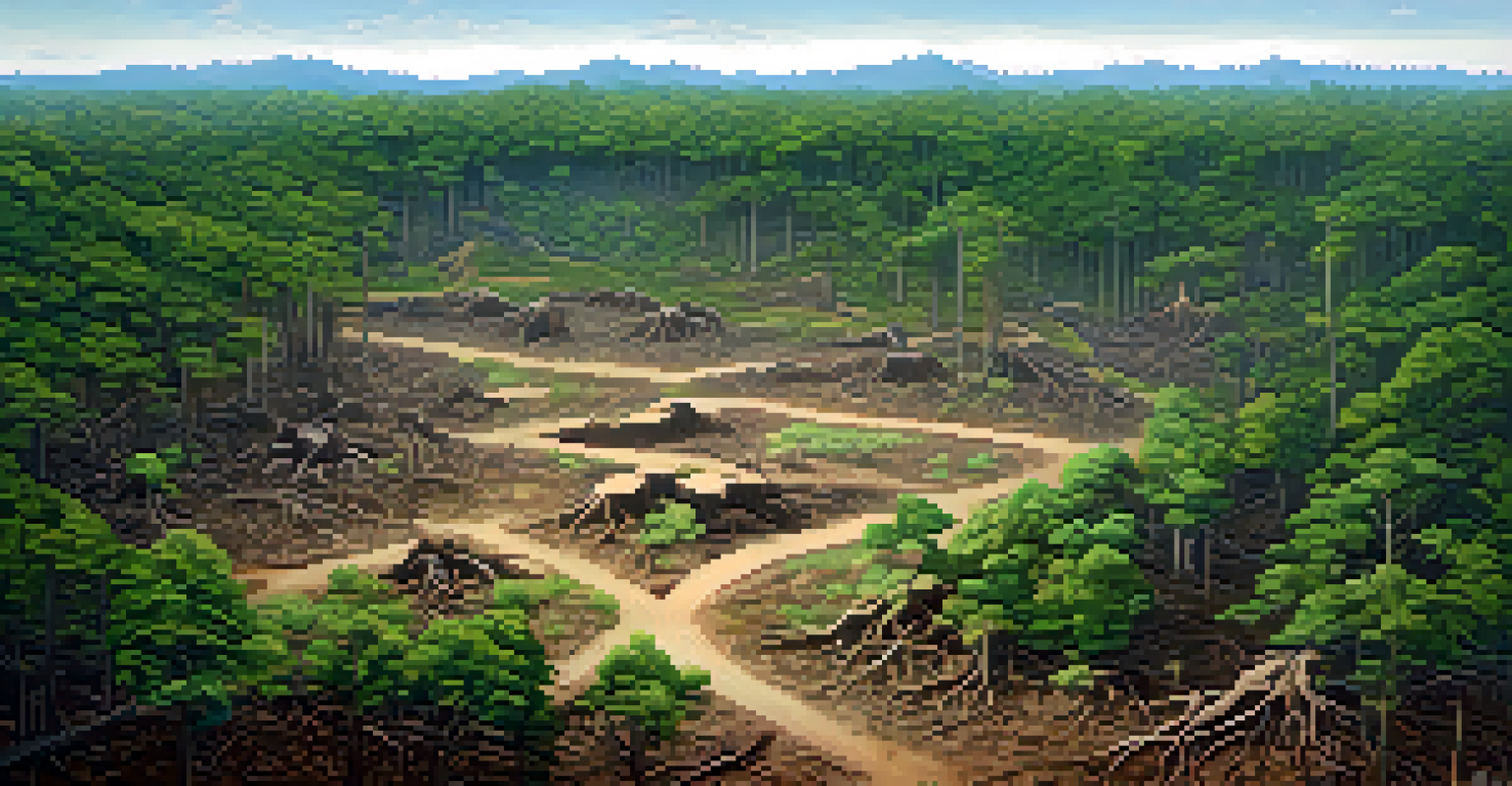The Connection Between Deforestation and Plant Extinction Risk

Defining Deforestation and Its Causes
Deforestation refers to the large-scale removal of trees from forested areas, often for agriculture, urban development, or logging. This process not only alters landscapes but also disrupts ecosystems. The primary drivers include the demand for timber, agricultural expansion, and infrastructure development, all of which feed into the cycle of habitat loss.
The clearest way into the Universe is through a forest wilderness.
As loggers clear land for profitable ventures, the delicate balance of ecosystems is thrown into disarray. For instance, the Amazon rainforest, often called the 'lungs of the Earth,' is experiencing rapid deforestation, leading to significant ecological consequences. It’s essential to understand that these actions are not just about trees; they trigger a domino effect affecting wildlife and plant life.
Consequently, when forests are cleared, the unique plant species that thrive there face severe threats. Many plants rely on specific conditions and relationships with other organisms, making their survival increasingly precarious as their habitats vanish.
The Link Between Habitat Loss and Plant Extinction
As forests are destroyed, the natural habitats that countless plant species depend on are lost. This loss leads to a decline in biodiversity, making ecosystems less resilient and more vulnerable to further disturbances. Plants play crucial roles in their environments, from providing food to stabilizing soil, so their extinction can have ripple effects.

Take, for example, the delicate orchids found in tropical rainforests. These beautiful plants often have very specific growth conditions and relationships with pollinators. When their habitats are altered or destroyed, these orchids can struggle to survive, leading to their potential extinction.
Deforestation Threatens Biodiversity
The large-scale removal of trees disrupts ecosystems and increases the risk of plant extinction.
Furthermore, the fragmented landscapes resulting from deforestation can isolate plant populations, making it difficult for them to reproduce. This isolation can accelerate the decline of species that are unable to adapt to the new, fragmented environment, highlighting the urgent need for conservation efforts.
How Climate Change Amplifies Extinction Risks
Deforestation doesn’t just eliminate trees; it also contributes to climate change, which further threatens plant species. As forests are cut down, the carbon stored in trees is released into the atmosphere, exacerbating global warming. This increase in temperature and changing weather patterns can have profound effects on plant survival.
We won't have a society if we destroy the environment.
For instance, many plants have specific temperature and moisture requirements to thrive. With climate change altering these conditions, even species that were once abundant can find themselves struggling to adapt. This struggle can lead to a decline in certain plant populations, pushing them closer to extinction.
Moreover, changing climates can introduce new pests and diseases that plants are ill-equipped to handle. The combination of habitat loss and climate stressors creates a perfect storm for many vulnerable plant species, making it critical to address both issues simultaneously.
The Role of Invasive Species in Plant Extinction
Deforestation often creates opportunities for invasive species to take hold in previously stable ecosystems. These invasive plants can outcompete native species for resources, further threatening their survival. When forests are cleared, the balance of native flora is disrupted, allowing aggressive invaders to thrive.
For example, kudzu, a vine native to Asia, has taken over many areas in the southeastern United States, smothering native plants and altering habitats. This invasion not only diminishes biodiversity but can also lead to the extinction of native species that cannot compete.
Climate Change Exacerbates Risks
Deforestation contributes to climate change, creating additional stress on plant species and their habitats.
As deforestation opens the door for these invasive species, the fight for survival becomes even more challenging for native plants. Efforts to control invasives must go hand-in-hand with preserving natural habitats to protect vulnerable species from extinction.
Conservation Efforts to Mitigate Extinction Risks
Addressing the connection between deforestation and plant extinction requires robust conservation strategies. Protected areas, reforestation efforts, and sustainable land use practices can help preserve existing habitats. By designating regions as conservation zones, we can provide safe havens for endangered plant species.
Additionally, reforestation initiatives can help restore ecosystems that have been damaged by deforestation. Planting native species not only aids in recovery but also helps in re-establishing the critical relationships between plants and their pollinators.
Community involvement is also crucial in these conservation efforts. Educating local populations about the importance of preserving their natural environment can lead to more sustainable practices and support for conservation initiatives, creating a collective impact on reducing plant extinction risks.
The Economic Value of Biodiversity
While the environmental aspects of deforestation are often highlighted, the economic value of biodiversity cannot be overlooked. Healthy ecosystems provide numerous resources, including food, medicine, and materials that are essential for human survival. Losing plant species threatens these resources, which can have dire economic consequences.
For instance, many pharmaceuticals are derived from plant compounds. The extinction of these plants could limit future discoveries and innovations in medicine. By preserving biodiversity, we not only protect ecosystems but also safeguard potential economic benefits that humanity relies on.
Collaboration is Essential for Conservation
Effective conservation strategies require cooperation between governments, NGOs, and local communities to protect vulnerable plant species.
Moreover, ecotourism thrives in biodiverse areas, providing income to local communities. By recognizing the economic importance of protecting plant species and their habitats, we can advocate for sustainable practices that benefit both nature and human society.
The Way Forward: Collaboration and Awareness
To effectively combat the threats posed by deforestation and plant extinction, collaboration is key. Governments, NGOs, and local communities must work together to develop and implement conservation strategies. By pooling resources and knowledge, they can create more impactful solutions to protect vulnerable plant species.
Raising awareness about the importance of preserving plant biodiversity is also vital. Educational campaigns can inform the public about the consequences of deforestation and inspire action. When communities understand the direct connection between their actions and the health of ecosystems, they are more likely to participate in conservation efforts.

Ultimately, fostering a culture of respect for nature and its complexities can lead to lasting change. By making informed choices and supporting sustainable practices, we can create a future where both humans and plants thrive together, reducing the risk of extinction.